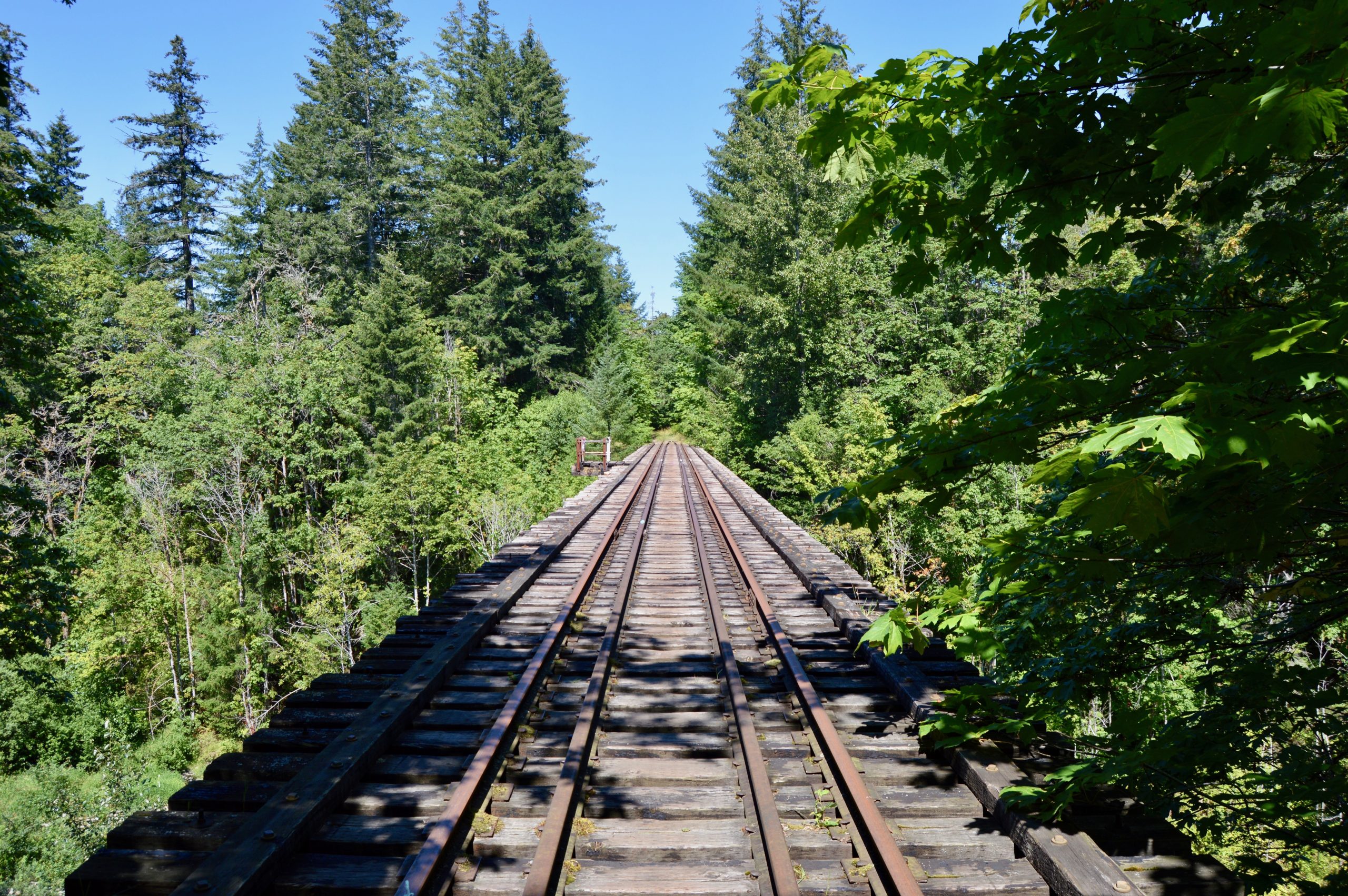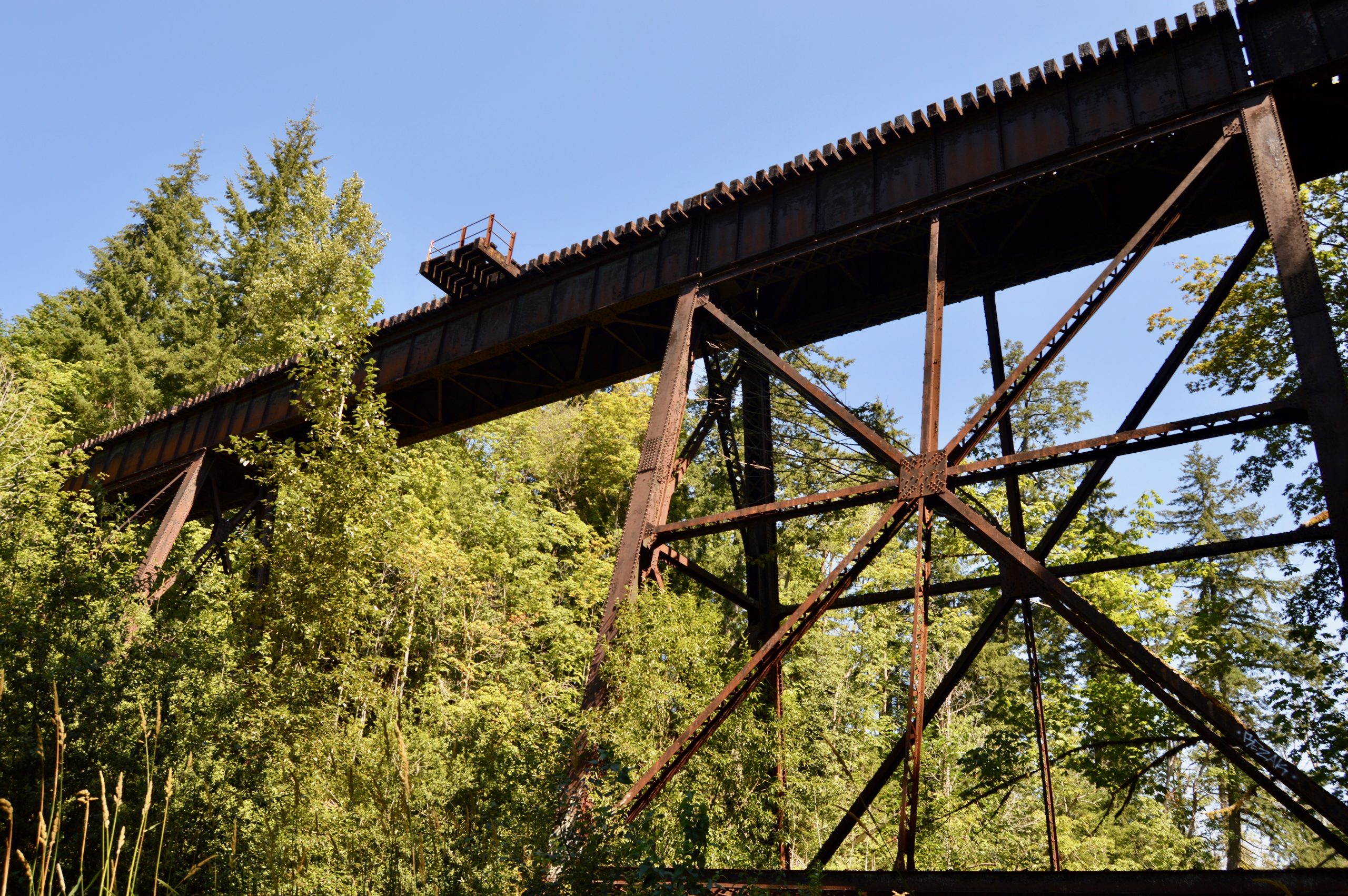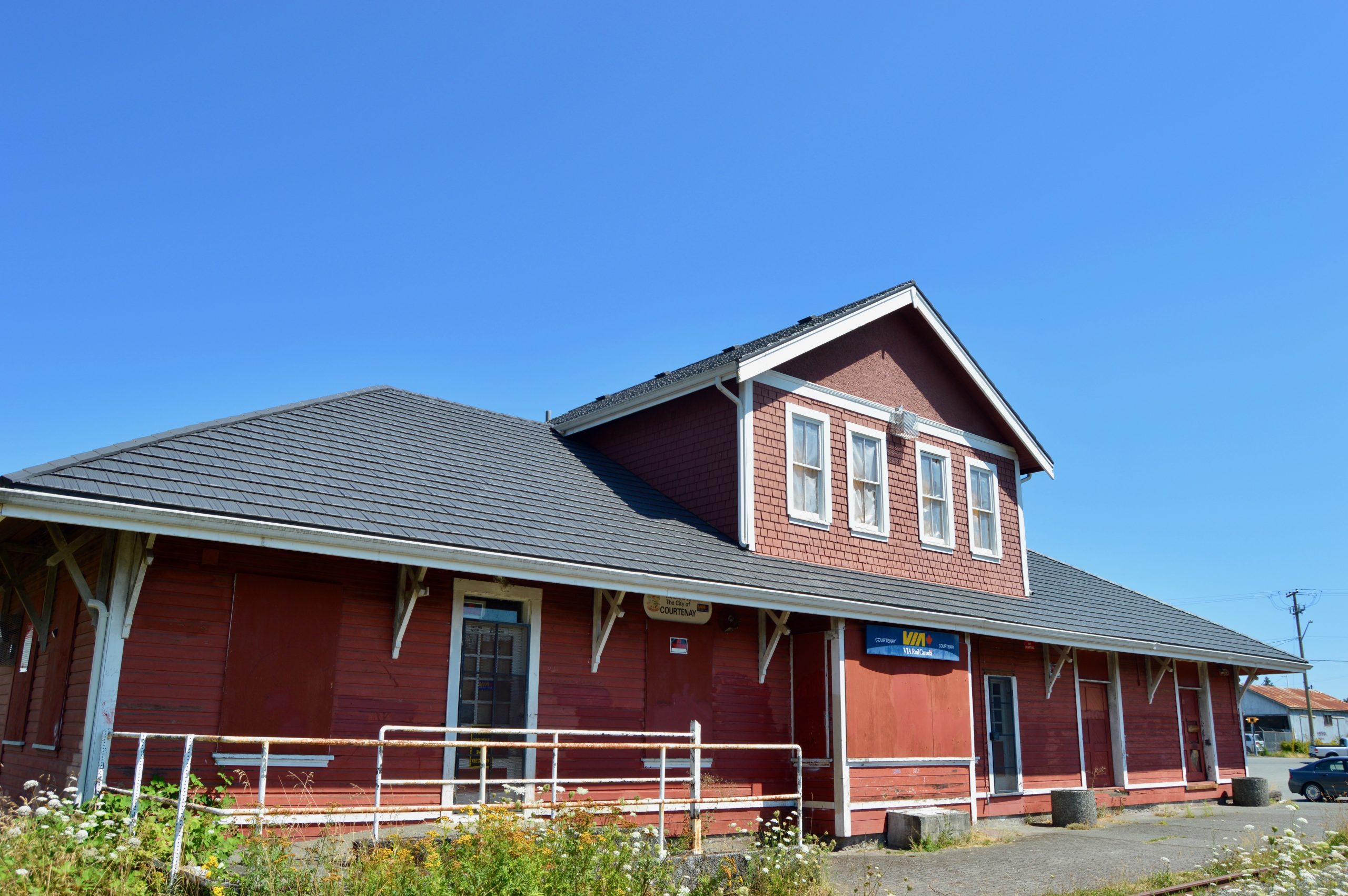Advocates say Vancouver Island’s dormant rail line could be better serving our communities — and students

Photo by Ethan Barkley.
It’s winter break after a long semester. Exams are completed, papers are in, and I’m ready to go to my family’s home in Comox and unplug for a few weeks. Relieved that I don’t have to brave winter conditions on the Malahat, I book a ticket on a morning train and catch a bus to the station, looking forward to a scenic and traffic-free journey up island.
The train leaves Esquimalt and heads up the Island Rail Corridor — formerly the E&N — winding through southern Vancouver Island, passing along the ocean near Nanaimo and heading back inland for the final stretch. The journey ends just outside downtown Courtenay — an easy spot to be picked up, or to catch a bus.
Sounds nice, doesn’t it?
The reality of up island travel is, unfortunately, much different. Vancouver Island does have an intact railway corridor, but trains haven’t run on it since 2011. In its absence, those who need to travel up island but can’t, or prefer not to drive, have few options.
BC Transit does have bus service between some island communities, but they are extremely infrequent. The bus from Victoria to Duncan runs four times a day on weekdays and doesn’t run at all on Sundays.
The remaining options are to carpool, be picked up by family, or to book passage on a privately-run bus service. Relying on someone else to drive is not always ideal, and while the bus service does the job, it gets expensive — especially for frequent travellers.
In March 2011, rail service was temporarily suspended due to potentially unsafe track conditions. Service was set to return in spring 2013, after maintenance could be done, but the deadline was then pushed to 2015.
In April 2015, the Island Corridor Foundation (ICF), the federally registered charity and non-profit which has owned the railway since 2006, announced that repairs would be further delayed while the provincial government conducted a review of the project.
In July, the B.C. government had affirmed its commitment of $7 million for the project, but by November the foundation was still awaiting the remainder of the funds — $7.5 million — from the federal government.
Late 2016 or early 2017 was given as the next prospective date for resumed service, provided that funding for repairs could be secured.
As of 2024, there is still no active rail service. Vancouver Island still lacks a reliable alternative to travel down- or up-island except driving, which is not an option for many Vancouver Islanders — including UVic students, who still feel strongly that the railway should return to service.
“A huge gap in transit services”

Photo by Ethan Barkley.
Despite over a decade of inactive rail service, interest in the future of the corridor has not dwindled. In fact, recent years have seen a resurgence of interest.
According to a UVic representative, 1580 UVic students are from central and northern Vancouver Island — almost 14 per cent of the student population.
University students who need to travel up-island — whether to return home, in the case of the almost 14 per cent, or for a co-op placement, a sport tournament, or for a weekend adventure — currently face a number of obstacles, ranging from gas and vehicle costs to concerns with time and road safety.
For students who lack their own vehicle, lack of travel options from Victoria to the rest of Vancouver Island can be a significant obstacle. By contrast, students from Vancouver who want to travel home have several bus options to get from downtown Victoria to Swartz Bay, where they can catch hourly ferries to Tsawwassen.
“The problem currently,” said Isabelle Easton, Director of Campaigns and Community Relations for the UVSS, “is that there’s not very many options when it comes to transit up-island, specifically when we’re talking about transit that connects Victoria to the Duncan-Nanaimo stretch of the Malahat highway, there’s only like a singular route you can take.”
Easton said interregional transit truly matters to students because it allows them freedom of mobility and also enables them to easily visit their families and communities.
Dylan Smith, a UVic computer science student without his own vehicle, says he’s fortunate that he can often carpool up-island with family members when he wants to visit home. When that option isn’t available, he relies on a privately owned bus service, but a combination of factors including cost, space, and reliability means it isn’t always convenient.
“[It] would be nice just to have a proper back and forth system of getting up and down the island [consistently],” he told the Martlet.
For students who do have their own car, travelling up-island can be a significant financial decision. “When I want to come up island, I have to think about the cost of it, because I would come and visit my parents way more often for a weekend, if it didn’t cost me probably 40 bucks [in gas] for a full trip up here,” said Faith Scoffings, a UVic engineering student from Bowser.
For Scoffings, weather and road conditions are another obstacle they have to consider when planning a trip home, especially in the winter months.
“In the winter, especially if I’m coming up for the holidays, I have a lot of beef with driving because I have a very small car and the roads are very dangerous,” they said.
For students, timing a trip can be just as challenging as affording one. While UVic offers a reading break around the middle of the semester, students are often overwhelmed with assignments by that time. Driving up-island can often take several hours — time that could otherwise be spent getting ahead on coursework.
Scoffings said their most recent trip up island took them three and a half hours due to traffic and construction — time they couldn’t use to do anything else.
While public transit options on Vancouver Island are often sufficient for getting around within the community, Todd Litman, president of Better Island Transit (BIT), says that there is a “huge gap” in transit services when it comes to interregional transit.
“If you want to travel from Victoria to Duncan, there are only four buses a day, and the fare is $10,” said Litman. “Those buses are oriented toward Duncan commuters coming to Victoria to work in the morning and returning in the afternoon. So there’s no way that a BC transit traveller could leave Victoria, do some business in Duncan, and return the same day.”
BIT, an advocacy group, is pulling for just this: the expansion of interregional transit, like that between Victoria and Duncan.
Litman says they are campaigning “to have frequent and affordable bus service, at least hourly service, [for] no more than $5 for each trip operating by next year.”
“When I was growing up in Bowser, before I had a car, I couldn’t go anywhere because there was a bus, like, once a day. So even going a couple cities over throughout my entire youth was a week’s planning,” said Scoffings.
Cassie, a Victoria resident, said her frequent drives up-island for work can be exhausting. “When you’re driving five, six hours in a day, then you literally need a day to rest,” she said. “You don’t realize when you drive for a long time the toll that it takes on your body.”
“I love trains so much. You could do anything on a train,” said Cassie. “You could listen to an audiobook, read a book, play games, even work on the train up, to get emails done,” she said. “Even coming back would be so much easier than driving. I would 100 per cent get on a train.”
Dr. Gordon Lovegrove, a professor of engineering at UBC Okanagan, advocates for a hydrogen powered light-rail transit system in B.C.’s interior, which would operate like a tram within cities and a regular train between them.
Lovegrove’s model is a similar train system which has existed in Karlsruhe, Germany, for around 40 years. He says this would facilitate greater connection between Okanagan Valley communities.
“This is good for the community. This is good for people, the environment, for our economy. We want a sustainable future, a cleaner B.C., in terms of climate action, zero waste, zero emissions. This is where we have to go,” said Lovegrove. “It’s a complex set of what I call tick boxes, where we’re connecting communities, we’re combating climate change, we’re reducing crashes, improving safety,” he said.
Lovegrove says that rail can fill many gaps in existing transit infrastructure, such as connecting people with healthcare services in other cities, or as a method of evacuation in the case of wildfires.
The benefits of Lovegrove’s proposal are not only relevant to the Okanagan Valley. Vancouver Island communities also stand to benefit from rail connection, including from access to healthcare services like the BC Cancer — Victoria centre, the only B.C. cancer facility on the island, or from another way in and out of southern Vancouver Island aside from the Malahat highway.
“Think about it from peoples’ perspective,” said Lovegrove. “A lot more of us, especially since COVID, want to live in these rural, remote areas. … This allows folks access to health care and other services regionally by just getting on a train.”
Lovegrove says he hopes to see a European model of governance instead of the private ownership often seen in North America, because “sustainable, stable transportation is a social determinant of health. When you have profit-motivated companies involved, the research is pretty consistent. They will just cut service, to maximize their loads and their efficiency, and the ultimate result is cancellation of service.”
Hydrogen-powered tram-trains are “a great fit in so many communities,” Lovegrove told the Martlet.
“Part of that modern world.”

Photo by Ethan Barkley.
The island railway’s origin story begins in the late nineteenth century, before B.C. joined Canada in 1871. One of the province’s terms in the agreement to join Canada was that a railroad had to be built to connect the province with the rest of the country “within two years of the date of the union.”
Dr. John Lutz, a UVic professor of B.C. history, says that getting a railway was a major issue for many British Columbians in the late nineteenth century. Railway connection with the rest of the country provided “a sense of tying the country together,” he said, but it also facilitated travel and access to other parts of Canada.
“This is just the high tech of the day,” said Lutz, comparing the rail technology of the time with modern high-speed rail technology, seen in countries like China. “That’s the prestige kind of technology today,” Lutz said. “British Columbians wanted to be part of that modern world.”
When the railway was not constructed within the promised 2 years, it provoked severe backlash. In 1874, B.C. threatened to withdraw from Canada due to lack of action from the federal government.
In the 1880s, the province settled on Robert Dunsmuir, the Nanaimo-based coal magnate and member of B.C. parliament, to build and operate the railway. Dunsmuir was initially reticent, but agreed to build the railway in exchange for a sizable cash subsidy as well as an enormous land grant — what amounted to nearly 20 per cent of Vancouver Island — including natural resources and mining rights.
“Dunsmuir was interested in it because he was already mining coal, and that’s mainly what he was interested in,” said Lutz. “He wanted to get all of the coal deposits on Vancouver Island.”
The land grant given by the province to Dunsmuir privatised more than 800 000 hectares of Indigenous land. The Hul’qumi’num Treaty Group, formed to facilitate treaty negotiations by its six member nations, refers to the land grant given to the E&N Railway, as the Island Rail Corridor was formerly known, as the “great land grab” and an “act of egregious piracy” because this land was granted to the E&N without knowledge, consultation, or consent of the Indigenous residents and owners of the land.
“That’s what the history is. It was an unconsented taking of an enormous amount of Vancouver Island. I think it’s like 20 per cent of the island that was effectively paid to create this private rail line by Dunsmuir,” said Thomas Bevan, CEO of the Island Corridor Foundation.
These land grants continue to impact modern treaty negotiations, says the Hul’qumi’num Treaty Group in a publication about the land grants, because much of this land remains in private hands today. “To date, the federal and provincial governments have refused to consider private lands in the treaty negotiation process.”
“When First Nations are negotiating treaties, the Crown has a lot of access to the land to restore to First Nations,” says Dr. Lutz, “[but] on southern and eastern Vancouver Island, there’s no Crown land. Zero. It’s become a huge impediment for modern treaty negotiations.”
In 1905, the railway was sold by Dunsmuir’s son, James, to the Canadian Pacific Railway (CPR), who expanded the length of the railway further north to its current end-point in Courtenay. CPR owned the railway property until 2006, when it was transferred to the ICF.
“It just needs to be fixed.”

Photo by Ethan Barkley.
The future of the railway has been a question mark on the map of Vancouver Island for over a decade now. However, many Vancouver Islanders seem more motivated than ever to explore what can be done with it.
“There’s an awful lot of history … around the E&N land grant, the history of the corridor, in terms of First Nation communities really paying the price for it and not getting much benefit. That needs to change,” said Bevan. “We need to have a future that the First Nations are driving and providing us with the insightful leadership and ways of living with the land that they have known since time immemorial.”
Warren Skaalrud, a southern Vancouver Island resident and passionate advocate for the restoration of rail service, has organized two petitions — one garnered 7 610 signatures before it was tabled in the House of Commons in February. The other, a change.org petition which is still active, has reached more than 20 000 signatures.
“People have a tendency to look at the railway as it is, the condition the tracks are in … they don’t look forward into the future and see what it will transform into over time, assuming we don’t lose it,” said Skaalrud.
Skaalrud says that the restoration of rail service on the island would have numerous benefits, ranging from more efficient transportation of goods for businesses on the island via freight, as well as benefits for tourists, young people, and the island’s growing population.
“Transportation ties into virtually everything. … If it’s cheaper to live here, then maybe we’ll get more nurses and doctors here, because we can live in a more healthy way. It has all of these interconnected pieces” said Skaalrud.
Sean Marshall, a Toronto-based geographer and transportation advocate, says rail has the potential to provide essential transport service to areas where climate may affect other forms of transportation.
“Climate change means different things to different parts of the country, but climate change means more adverse weather effects and more chances of road washouts and flooding, [so] you want to make sure there’s alternatives.”
Taj, a Victoria resident involved in advocacy for the railway, says he became more interested in the railway when he was first commuting into the city for work but had yet to find housing.
“I was commuting for the first two months I lived here. I was commuting back and forth every single day…and I thought it would be so much nicer to just board a train that would take you to Victoria and back,” he said, “and the funny thing is, we have that. We have all the infrastructure, we have all the tracks. It just needs to be fixed.”
Taj said he’s disappointed by the lack of action on rail in Canada and the US, compared to other countries like China, Japan, India and many in Europe.
Others, like Litman, are critical of the proposal. Litman and Better Island Transit want to get frequent and affordable bus service going as soon as possible, to fill the gaps in interregional transit, rather than waiting for a decision to be made about the railway.
In response to Skaalrud’s petition, Canadian Transport Minister Pablo Rodriguez said in March that Canada “has committed to establishing a permanent, predictable federal fund to support public transit and active transportation solutions beginning in 2026-27,” and promised more details on this fund later in 2024.
The provincial government, meanwhile, provided $18 million in March 2023 “to allow for future corridor planning involving affected First Nations and regional districts,” when it also returned 10 acres of land to the Snaw-naw-as First Nation which was taken for the railway in the 1900s, and had bisected their land ever since.
“This is a historic day for the Snaw-naw-as Mustimuxw. Rail has served an important purpose for British Columbia,” reads a public statement from Snaw-naw-as elected Chief and Council Gordon Edwards (Sul-aux-mait), “but this came at the expense of hindering the Snaw-naw-as and other First Nation communities.
“We sincerely hope that the Corridor once again benefits all people of Vancouver Island. There are many questions about what lies ahead for the rest of the corridor, but for today, we celebrate the successful return of our land.”
Bevan says the ICF is in the midst of a “shared vision project” with their member communities to figure out the best way for the corridor to serve its members.
Restoring rail service is “definitely on the table,” he said. “Everything is on the table with the corridor. The most important thing is that it needs to be driven by the community and particularly our members … what our members want is what we want.”








